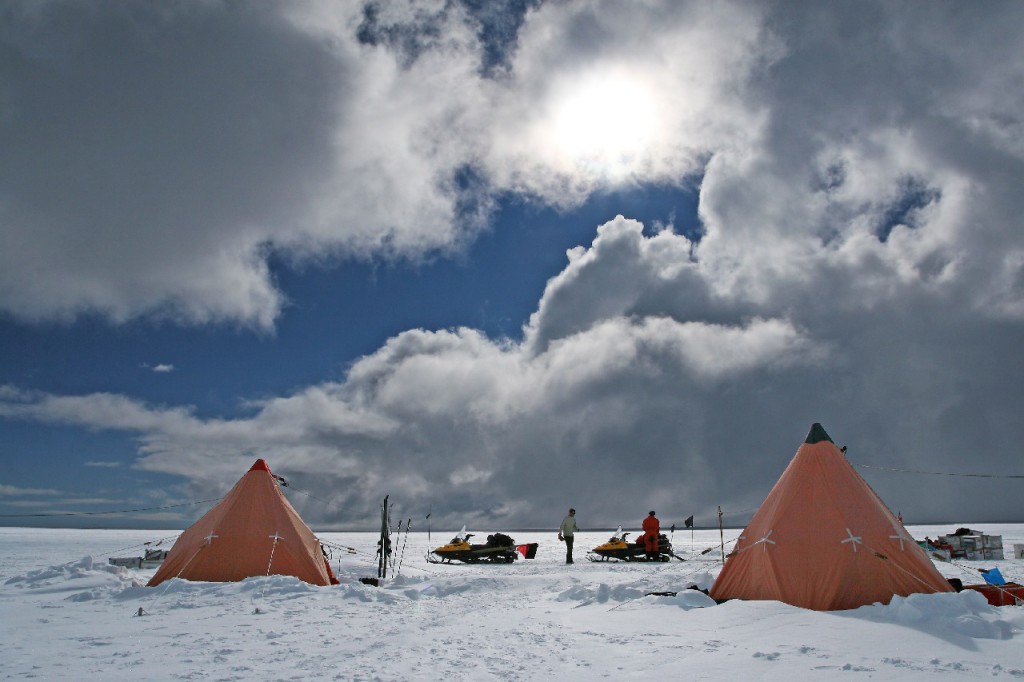New insight into accelerating summer ice melt on the Antarctic Peninsula
A new 1000-year Antarctic Peninsula climate reconstruction shows that summer ice melting has intensified almost ten-fold, and mostly since the mid 20th Century. Summer ice melt affects the stability of Antarctic ice shelves and glaciers.

The research, published this week in the journal Nature Geoscience, adds new knowledge to the international effort that is required to understand the causes of environmental change in Antarctica and to make more accurate projections about the direct and indirect contribution of Antarctica’s ice shelves and glaciers to global sea level rise.
In 2008 a UK-French science team drilled a 364-metre long ice core from James Ross Island, near the northern tip of the Antarctic Peninsula, to measure past temperatures in the area. They discovered that this ice core could also give a unique and unexpected insight into ice melt in the region.
Visible layers in the ice core indicated periods when summer snow on the ice cap thawed and then refroze. By measuring the thickness of these melt layers the scientists were able to examine how the history of melting compared with changes in temperature at the ice core site over the last 1000-years.
Lead author Dr Nerilie Abram of The Australian National University and British Antarctic Survey (BAS) says,
“We found that the coolest conditions on the Antarctic Peninsula and the lowest amount of summer melt occurred around 600 years ago. At that time temperatures were around 1.6°C lower than those recorded in the late 20th Century and the amount of annual snowfall that melted and refroze was about 0.5%. Today, we see almost ten times as much (5%) of the annual snowfall melting each year.
“Summer melting at the ice core site today is now at a level that is higher than at any other time over the last 1000 years. And whilst temperatures at this site increased gradually in phases over many hundreds of years, most of the intensification of melting has happened since the mid-20th century.”
This is the first time it has been demonstrated that levels of ice melt on the Antarctic Peninsula have been particularly sensitive to increasing temperature during the 20th Century.
Dr Abram explains,
“What that means is that the Antarctic Peninsula has warmed to a level where even small increases in temperature can now lead to a big increase in summer ice melt.”
Dr Robert Mulvaney from the British Antarctic Survey led the ice core drilling expedition and co-authored the paper. He says,
“Having a record of previous melt intensity for the Peninsula is particularly important because of the glacier retreat and ice shelf loss we are now seeing in the area. Summer ice melt is a key process that is thought to have weakened ice shelves along the Antarctic Peninsula leading to a succession of dramatic collapses, as well as speeding up glacier ice loss across the region over the last 50 years.”
In other parts of Antarctica, such as the West Antarctic Ice Sheet, the picture is more complex and it is not yet clear that the levels of recent ice melt and glacier loss are exceptional or caused by human-driven climate changes.
Dr Abram concludes,
“This new ice core record shows that even small changes in temperature can result in large increases in the amount of melting in places where summer temperatures are near to 0°C, such as along the Antarctic Peninsula, and this has important implications for ice instability and sea level rise in a warming climate.”
This research was funded by the Natural Environment Research Council. Dr Abram is an Australian Research Council Queen Elizabeth II Fellow.
ENDS
Issued by the British Antarctic Survey and the Australian National University Press Offices.
Contact:
Dr Nerilie Abram — Tel: +61 (0) 2 6125 1978 (office); Mob: +61 (0) 408 557014; email: nerilie.abram@anu.edu.au
Dr Robert Mulvaney — Tel: +44 (0) 1223 221436 (office), Mob: 07941 783364; email: rmu@bas.ac.uk
Australian National University Press Office:
Tegan Dolstra: email is media@anu.edu.au, office phone is +61-2 6125 4171.
British Antarctic Survey Press Office contact:
- Paul Seagrove, Tel: +44 (0) 1223 221414; Mob: +44 07736 921693; email: psea@bas.ac.uk
- Paul B. Holland, Tel: +44 (0)1223 221226; Mob: + 44 07740822229; email: pbmho@bas.ac.uk
Notes for editors:
The paper: Acceleration of snowmelt in an Antarctic Peninsula ice core during the twentieth century by Nerilie Abram, Robert Mulvaney, Eric Wolff, Jack Triest, Sepp Kipfstuhl, Luke Trusel, Françoise Vimeux, Louise Fleet and Carol Arrowsmith is published in Nature Geosciences 14 April 2013
Authors:
Nerilie J. Abram1,2*, Robert Mulvaney1*, EricW.Wolff1, Jack Triest1,3;, Sepp Kipfstuhl4 Luke D. Trusel5, Françoise Vimeux6, Louise Fleet1 and Carol Arrowsmith7
- British Antarctic Survey, Natural Environment Research Council, Cambridge CB3 0ET, UK,
- Research School of Earth Sciences, The Australian National University, Canberra, Australian Capital Territory 0200, Australia,
- UJF-Grenoble 1/CNRS Laboratoire de Glaciologie et Géophysique de l’Environnement (LGGE) UMR 5183, Grenoble F-38041, France,
- AlfredWegener Institute for Polar and Marine Research, D-27568 Bremerhaven, Germany,
- Graduate School of Geography, Clark University,Worcester, Massachusetts 01610, USA,
- Institut de Recherche pour le Développement, Laboratoire HydroSciences Montpellier et Laboratoire des Sciences du Climat et de l’Environment, 91191 Gif-sur-Yvette, France,
- NERC Isotope Geosciences Laboratory, British Geological Survey, Keyworth NG12 5GG, UK.
